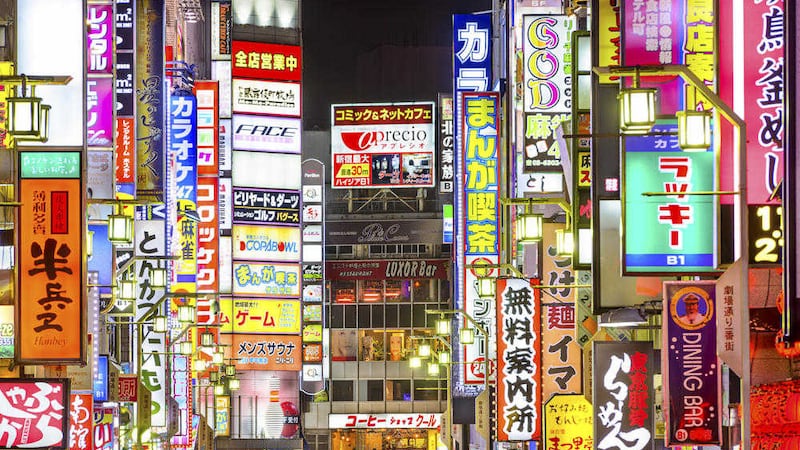PERHAPS you have put off visiting Japan, fearful of the expense. I did and am now kicking myself for leaving it so long. Costs are not prohibitive and can be kept within a budget if you plan ahead and work the options. Terrific experiences are in store for the traveller looking for new horizons.
Tokyo is instantly everything you expect it to be: a blazing intensity of neon, audio-visual adverts on the streets like something from Blade Runner and a subway system, best compared to a Rubik Cube, which makes negotiating, the (more expensive) London Underground mere toddler’s play.
Tokyo can become overpowering in a matter of days but before you escape the urban overdose there is time to shop for lovely Japanese souvenirs at the Oriental Bazaar store, a splurge at the Palace hotel and meals at restaurants with deserved names like Brilliant and Dazzle.
Kyoto, once the ancient capital and still the spiritual heart of Japan, is where Scarlett Johansson found her Zen moment in Lost In Translation but with coaches disgorging tourists from China on an industrial scale, this is not an experience waiting to happen.
The kimono-clad women you see are not geisha but tourists hiring a costume for the day.
Some of the big Buddhist temples can be overcrowded but at Fushimi-Inari Taisha, a complex of Shinto shrines spread across the wooded side of a mountain, you can go for a hike around the upper precincts.
Kyoto’s Botanical Gardens, the oldest in the country, are another must-see sight: 500 cherry blossom trees and a conservatory rivalling Kew’s.
There is no shortage of places of stay, from budget inns to five-star de luxe. Of the city’s best two hotels one is Suiran, with its Japanese garden and tranquil riverside location, parks and walking trails on the doorstep. The other is the low-rise Ritz-Carlton, with a backdrop of the mountains enclosing Kyoto and a lovely Italian restaurant for one of those times when you need a break from Japanese cuisine.
The Kyoto Handicraft Center displays adorable products of the city’s centuries-old arts. Potters are concentrated in one neighbourhood and at Unraku-gama you can visit the store and workshop of a family business turning out exquisite ceramics for the last 125 years.
With a Japan Rail Pass it is easy to vroom between Tokyo and Kyoto (from Tokyo, sit on the right side for splendid views of Mt Fuji) but you must also get away from the famed destinations and head south to Fukuoka. You can take a flight there or a train from the capital. The airport is virtually in the city so no skyscrapers but there is Fukuoka Tower (234m), worth ascending to appreciate the city’s grand coastline location.
The Hilton Seahawk hotel, built on the seafront, is close to beaches while With the Style is as voguish a hotel as you could possibly get: a riot of sub-tropical vegetation coating the exterior and eye-popping interior design (plus a free bar in the evenings) sets the place apart.
Fukuoka’s food scene is incomparable and runs the gamut from a Michelin two-star puffer fish restaurant – a culinary form of Russian roulette – to meals on wheels at mobile street kitchens, called yatai. Hidden behind curtains of plastic, they serve up bowls of delicious noodles for £3, enjoyed with sake or beer while rubbing shoulders with friendly locals on wooden benches.
At least one night’s sleep should be on a futon on tatami mats in a ryokan (traditional inn), complete with shoji screens and a Japanese garden. A local train from Fukupoa takes you to the small seaside town of Karatsu, famous for its pottery and home to Yoyokaku. This family-run ryokan wraps itself around a serene garden, designed in the 19th century, and dinner is served in your room. Perfection.
Fukuoka is a transport hub and, with budget airline Peach selling return air fares to Okinawa from £46, within two hours you can be sunbathing on a semitropical island.
As well as tropical warmth and hotels fronting ocean beaches, there is wonderfully healthy food to enjoy here – Okinawans, in a country with the world’s longest life expectancy, live longer here than anywhere else in Japan so it makes sense to eat what they do. Their Ishigaki beef is renowned in Japan and great value at Makishi Public Market in Nara, Okinawa’s capital, where you can also have it cooked and served at reasonable prices.
The Second World War has not been forgotten on Okinawa and the war memorials and museum are dignified but harrowing testimony to what happened on the island in 1945. American forces still have a huge presence here, 26,000 personnel in over 30 bases, but all the Okinawans I spoke to are not happy with this.
You can also fly from Fukuoka to Yakushima, an island which is a Unesco World Heritage Site and utterly different to the rest of Japan. Being a tree nerd, I came here to see the yakusugi – ancient cedar trees which clothe the sides of the mountains that dominate the island – reachable on numerous short or long hikes.
Shopping malls do not exist on Yakushima but creature comforts abound at Sankara Hotel, including a spa, and a superb restaurant where most of the ingredients, from the grapefruit in the pastries at breakfast to the kumquat in desserts, are grown on the island.
Whatever you do or see and wherever you go there is the constant surprise of everyday Japanese culture which seems light years away from life back home. It probably isn’t once you scratch the surface but while you’re there the etiquette, the bowing and meticulous attention to detail is a wheeze.
Maybe, like me, you’ll return home wanting to build a small rock garden, eat more fish, live calmer and encourage taxi drivers to go Japanese and wear white gloves.
FACT FILE
:: Air France has good fares via Paris and JAL (Japan Air Lines) flies direct from London.
:: A Japan Rail Pass provides unlimited rail travel. A seven-day pass is available from £152 and getting one through Japan Experience includes a map and timetable (japan-experience.com).
:: In Tokyo buy a Pasmo or Suica card from a subway vending machine to avoid the hassle of purchasing individual tickets.
:: The New York Bar (restaurants.tokyo.park.hyatt.co.jp) is where Bill Murray lounged in Lost in Translation
:: For a splurge, staying at the Palace Hotel (en.palacehoteltokyo.com) is hard to beat and its private balconies are a rarity in the space-challenged metropolis.
:: For Kyoto information see Kyoto.travel/en.
:: Lonely Planet’s Japan guide helps a lot with the practicalities of travelling around Japan and, to whet your appetite for Japanese food, try Rice Noodle Fish by Matt Goulding (Hardie Grant).








